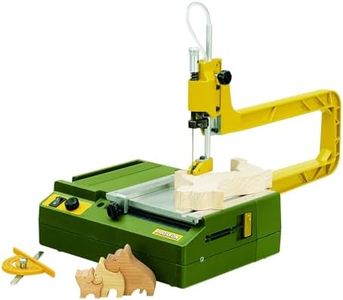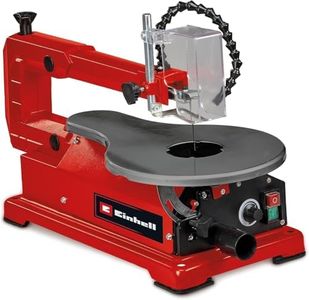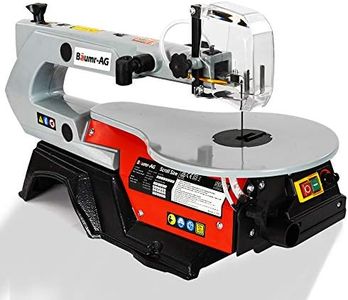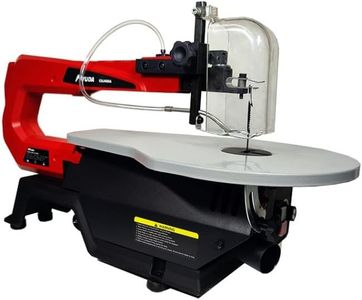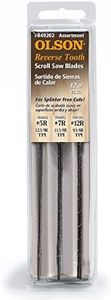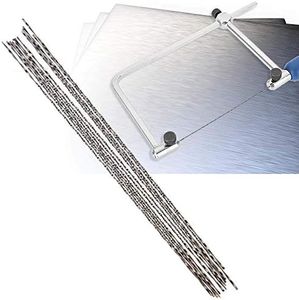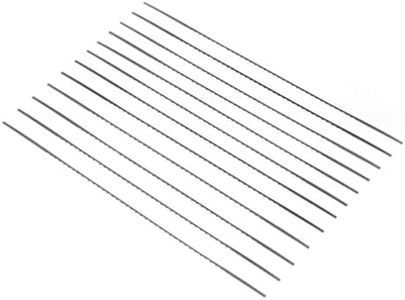We Use CookiesWe use cookies to enhance the security, performance,
functionality and for analytical and promotional activities. By continuing to browse this site you
are agreeing to our privacy policy
10 Best Scroll Saws
From leading brands and best sellers available on the web.Buying Guide for the Best Scroll Saws
Choosing a scroll saw can seem overwhelming, but it becomes much easier once you understand the key features that matter for your projects. Scroll saws are designed for detailed, intricate cuts in wood, plastic, or thin metal, making them popular for crafts, woodworking, and DIY enthusiasts. To select the best scroll saw for you, it's helpful to know what each important specification means and how it impacts your experience. Think about the types of materials and projects you plan to handle, the space you have available, and your comfort with tools, as these considerations will help you find a saw that matches your needs.Throat DepthThroat depth refers to the distance from the blade to the rear frame of the saw, and it determines how large a piece you can cut. A smaller throat depth (around 12 inches or less) limits you to smaller workpieces, which is fine for crafts or small shapes. Mid-range depths (about 16 to 18 inches) are suitable for most hobbyists, handling a wide array of project sizes. Larger throat depths (20 inches or more) are suited for more ambitious or professional projects where big, intricate patterns are needed. Choose based on the largest piece you plan to work with; if you're unsure, mid-range sizes often strike a good balance for beginners and general use.
Blade TypeScroll saws use two primary blade types: pinned and pinless. Pinned blades are easier to install and are good for straightforward work with thicker materials, but their pins can limit your ability to make tight, detailed cuts. Pinless blades come in a wider variety, allowing for finer, more intricate designs and tighter curves, but require a bit more skill to install. If your projects require detailed pattern work or you are interested in more versatile cutting, go with a scroll saw that accepts pinless blades. If you want a simpler tool for basic use, pinned blades may be suitable.
Variable SpeedVariable speed allows you to adjust how fast the blade moves, which is important because different materials and cut types require different speeds. Lower speeds are best for delicate materials like plastic or for intricate, detailed cuts, reducing the risk of burning or melting. Higher speeds work well for rougher or harder materials and quicker straight cuts. If you need to work with a variety of materials or want more control over your work, a variable speed scroll saw is highly recommended as it adds versatility and precision to your work.
Table TiltTable tilt enables you to angle the work surface, making it easier to cut bevels or angled shapes. Some scroll saw tables tilt to one side only, while others offer tilting in both directions (left and right). For most hobbyists, a table that tilts up to 45 degrees in at least one direction is sufficient for occasional bevel cutting. If you anticipate doing more complex angled work, a dual-tilting table offers greater flexibility. Consider how much angled or beveled cutting you actually plan to do before prioritizing this feature.
Blade Change MechanismHow easily and quickly you can change blades affects your workflow, especially if your projects involve different blades for various cuts. Some scroll saws have tool-free blade change systems, while others require wrenches or other tools. Tool-free changes are much more convenient and save time, particularly for beginners or those who often switch between blades. If ease-of-use and quick adjustments are important to you, look for a scroll saw with a tool-free blade change design.
Vibration and Noise ControlScroll saws can vibrate and create noise while cutting, which can affect your comfort and the accuracy of your cuts. Saws with better vibration and noise control use heavier materials or special designs to minimize movement and sound. If you value precision, plan to work for long periods, or have a shared workspace, choosing a scroll saw known for being stable and quiet will make the experience much more pleasant. Lighter or lower-quality models may be louder and more prone to shaking, impacting your results.
